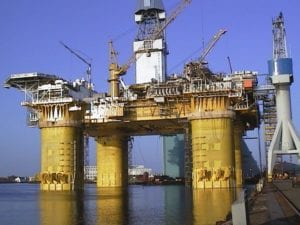China’s economy eclipsing Japan as the world’s second largest economy has long-lasting impact on global energy production, consumption and prices. These macro changes are not fleeting but structural, and are shifting the cyclical rhythm of the global oil and gas market.
Global trends, LNG and high oil prices By Adi Karev* It used to be sufficient to view global oil and gas trends in the typical cyclical rhythms the industry moves in. But, in the last 5-10 years, significant macro changes caused spikes in the usual metrics we evaluate, that is production, consumption and price. For example, China’s economy eclipsing Japan as the world’s second largest economy has long-lasting impact on global energy production, consumption and prices. The shift that is occurring is a new balancing of the geographic flow of petroleum supply and demand, a balancing of fuel types, and of the types of players involved. To explain this balancing trend, here are some examples: – resurgence of the global LNG trade – development of unconventional natural gas – sustainment of high crude prices driving riskier energy and petroleum (E&P) investments – the rising cost of doing business. Global LNG developments In the early 2000s, about 10 countries exported liquefied natural gas (LNG), trade was based on long-term sales agreements and flowed from producers in South-east Asia and the Middle East to consumers in East Asia and Europe. Today LNG is slightly looking more like a globally traded commodity with greater spot trading(prices ranging from $US4 to $US17 (R31.50-R134.30) per MBTU), new exporters in Latin America and West Africa, and new importers such as China and India. In five more years, there will be more exporters in North America, Eastern Mediterranean, and East Africa. And by 2035, LNG could account for 50%of the international gas trade, increasing from 26% in 2002. The emergence of new LNG exporters and importers changes the dynamic of energy geopolitics. A potential scenario of Europe buying gas from Israel’s Leviathan field or from the United States Gulf Coast, and less from Russia, could change the supply security in the region. The growth of LNG also signals a shift in fuel mix as countries such as the United States, China, Australia and Japan see a future more reliant on natural gas than coal in the United States and China, and nuclear in Japan. Currently, the tight supply of LNG and high demand from Japan in the aftermath of the Fukushima disaster has created a wide price spread. In 2011, Japan paid as high as US$18 per MBTU for spot cargoes of LNG to meet domestic demand, while North America gas prices remained at around US$4 per MBTU. According to economics, the law-of-one-price means global LNG prices will equalise in the long-term. Though, in the near-future, we may continue to see a high price spread considering that ship orders will be fulfilled around 2015, final investment decisions for major LNG projects in Australia will also be made by this time and, post-2015, we may see significant LNG volumes exported from North America. The upward trend of LNG prices creates opportunities in further developing the global market. National Oil Companies (NOCs) and major international players are forming partnerships in LNG projects, which include E&P and downstream infrastructure development. Chinese NOCs offer much needed cash for expensive projects, especially in Australia, and in exchange the NOCs secure future supply and can potentially play the price arbitrage opportunity. The price spread, diversified market of producers and consumers, and infrastructure development creates conditions for players to exploit price differences and divert LNG cargoes to higher-paying buyers. This development is notable because it drives innovation in contract clauses, trading models, and price information sharing, which are the seeds to grow LNG into a globally traded commodity.The global LNG market outlook appears to be bright, which is good news for sub-Saharan Africa. Nigeria as a top producer of LNG will soon be joined by Angola, and possibly Mozambique and Tanzania, bringing much-needed production capacity to the market. There are significant challenges throughout the LNG project lifecycle, first of which is developing natural gas fields, especially offshore. The capital intensity of liquefaction infrastructure is compounded by costs related to labour and regulatory processes.
Unconventional gas Part of the LNG equation is unconventional gas. Shale gas and coal-bed methane resources make it possible for the United States and Australia, respectively, to be top LNG exporters by 2020. The theme of re- balancing is clearly seen in the case of the United States where the shale gas potential could reverse the country’s trade flow and make it a net exporter. Indeed, plans have been approved in the United States Gulf Coast to retrofit LNG import facilities into exporting ones. The trend of unconventional gas development is a global one. Countries that seemed to be destined as net importers of energy face the prospect of self-sufficiency. Shale gas exploration projects are occurring in China, India, Poland, Argentina, Germany, and South Africa. The major impediments to shale gas development include cost, labor, drilling complexities, and above all, the controversy surrounding fracking, which has been felt in South Africa given the government moratorium. High oil prices boost E&P The surge in natural gas doesn’t mean petroleum producers have looked away from oil. Following the typical cycle, high crude prices are incentivising producers to invest in E&P projects. The new shift is that it has become economical for companies to go deeper and riskier. Of course a high crude price isn’t the only factor explaining E&P at greater offshore depths; technology and depleting supplies are other major drivers. But high crude prices change thresholds for what is deemed economically recoverable, especially for risky areas such as the Arctic waters. The United States government approval for drilling off the coast of Alaska is advancing, Russia plans to begin drilling this year, and Greenland has already licensed off blocks. Drilling in such harsh environments requires significant Capex for specially designed rigs and spill response technologies. Overall, the uptick in E&P projects is markedly offshore, with spending in offshore Capex projected to be about US$250 billion from 2012-2016 and concentrated in West Africa, Brazil and Asia Pacific. E&P offshore and in complex formations, like unconventional oil and gas, require high-end seismic and drilling capabilities, and this means growth for the oilfield services sector. This sector has typically been dominated by major international players but NOCs with OFS subsidiaries are stepping up their operations to capture a piece of the growth. This is yet another example of a re-balancing dynamic. Rising cost of doing business Although capital expenditures and petroleum discoveries are on the rise, so too are operating costs. One of the main drivers of increased Opex is higher wages, and this could be a long-term problem with a perceived shortage of skilled labour. In a recent survey of petroleum executives conducted by The Economist, shortage of skilled labor was listed as the second major barrier to growth. The labour factor is an acute challenge in Canada and Australia where unconventional exploration is more labour-intensive, the shortage of skilled workers drives up wage rates, and locations are remote requiring additional costs. For Australia, the labour rates are compounded by rising construction costs causing LNG projects to be delayed and over budget. Ultimately these costs drive up the price of LNG and may impact the competitiveness of Australian LNG once other production comes online. In the same survey, 82% of the petroleum executives agreed that government regulation has become more important. Increased regulation also impacts operating costs. Related to government regulation is the revision of petroleum fiscal policies. High crude prices amid slumped GDP growth are prompting governments to re-examine profit-sharing agreements, and governments with new petroleum sectors are carefully crafting their petroleum policies. Governments revising such policies struggle to balance increasing revenue with encouraging investment. Using Brazil as an example, the government last year amended production-sharing agreements to mandate a 30% stake for Petrobras on strategic blocks and an oil outtake for the government. Putting these cost factors together, we should expect the oil and gas industry to continue to invest strategically, but take active and forward-looking management of risk in light of rising operating costs, increased regulation and government-friendly petroleum fiscal regimes. What we see from these market developments is the upcoming dominance of natural gas (balancing fuel mix), emergence of new producers and consumers (balancing geographic trade flows), and rise of NOCs throughout the value chain (balancing players). The oil and gas industry in sub-Saharan Africa, with its long petroleum history and bright future in offshore and unconventional resources, stands squarely in these balancing dynamics. Understanding this balancing trend offers a framework to uncover potential risks, and opportunities for investments, partnerships and cooperation.







